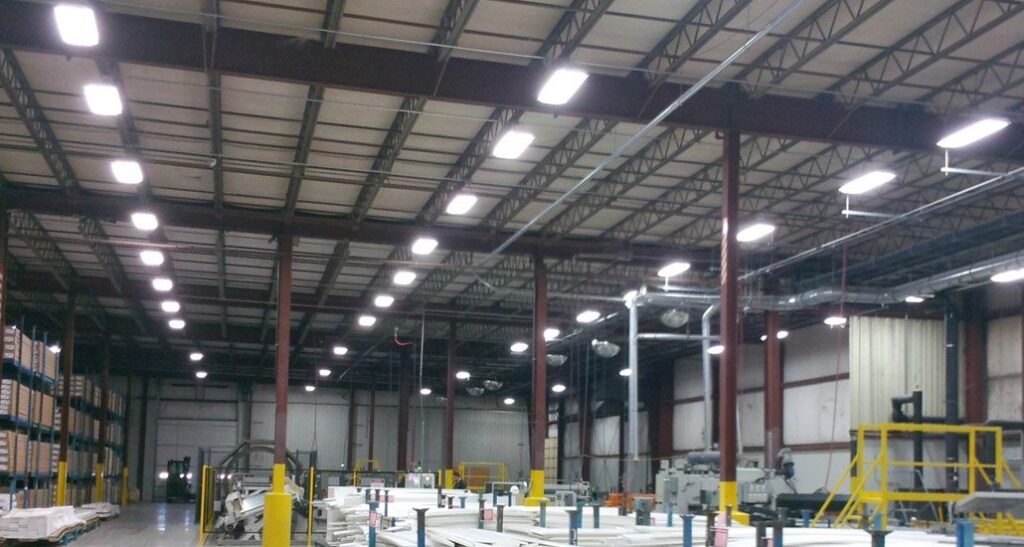Ever since the introduction of high bay lights to fulfill the lighting requirements of a large space such as a warehouse, the concerns regarding lighting scheme of a facility have been comprehensively addressed.
Lighting is a necessity, while the size of the warehouse varies from business to business depending on the type of items stored there.
This article is prepared to address all the general concerns related to lighting requirements of a warehouse depending on its architectural layout.
Why High Bay lights?
The usual ceiling height of a warehouse is more than 20 feet and can be around 40 feet which is quite a huge space. High bay lights being a powerful lighting source are specially designed for warehouses and industries.
General features of a warehouse
Usually, lighting contractors have the exact tools to calculate the number of fixtures per square yard. It depends solely on a few features of the building such as:
- Area per square feet of a room/ area of sub facilities inside the warehouse
- Height of the ceiling
- Total area of warehouse building or
- Lumens required per square feet.
Each warehouse has several subunits where different tasks are carried out which help determine the lighting requirement of each area.
- Storage
- Corridors
- Dressing area/toilets
- service area
- Cafeteria/waiting area
- shipping area
- loading/unloading area

Warehouses are designed to have large vertical and horizontal spaces to accommodate the necessities of each and every single task which is meant to be carried out there.
In order to illuminate storage areas, lighting dedicated to aisle layout is preferred to avoid any hindrance in visibility of the labeled shelves and products as the aisles extend upwards nearly touching the roof.
Similarly the assembling area where the use of heavy transport machinery is common requires general plus task lighting which should be bright enough to comply with visibility of specific labels or warnings.
In other areas such as corridors, cafeterias etc, general lighting is a good fit which means light is bright enough to enhance general features of the area for workers compliance.
Using lights integrated with motion sensors or controlled through a remote controlling device gives the benefit of reduced electrical costs all over as not all areas require lighting at all hours of the day.
The question stands “how many led high bay lights do I need for my warehouse?”
A proper lighting scheme as per requirement of each subunit of a warehouse is devised with the help of a lighting contractor.
The contractor will assist you in getting a quote for the lumens required per square feet and will tell you the exact number of light fixtures required to meet the requirements of your lighting layout plan.
General Requirements
In order to design a lighting scheme for a certain warehouse the few features of lighting fixtures that will be used (led high bay lights, in this case) should be considered which are:
Lumens:
It is the amount of visible light produced by a lighting source which is measured by calculating the brightness of the light produced.
Lux:
This is the SI (International System or metric) unit of illuminance that determines the intensity of light given off from a light source as perceived by the human eye from a certain distance. One lux is equal to lumen per square meter.
Footcandle (american system):
is an IP (inch-pound) unit of illuminance or illumination received by a surface at a distance of one foot from a source of intensity (1 foot candle=1 lumen/square foot).
These units of measurement determine the quantity of light to meet certain requirements with smart management and reduced cost by the use of a light meter which either measures in lux (lumens per square meter) or footcandles (lumens per square foot) at an horizontal and vertical plane where the task is performed.
The difference in two planes is due to the fact that lighting intensity differs on vertical planes as compared to horizontal planes to aid in visibility of the shelves and labels.
The table below shows approximate lighting requirements of each subunit of a warehouse according to the tasks carried out there.

Please note that this table can be used as a reference as these are general calculations based on standard and it can vary according to the size and requirements of your warehouse.
| Level and type of activity in the space | Recommended lux (lx) or foot candles(fc) |
| Infrequent use(public spaces,corridors) | 2-5 foot candles or 20-50 lux |
| Active/regular use(lunch area,locker rooms,docks) | 10-20 foot candles or 100-200 lux |
| Assembling of small items | 50-100 foot candles or 550 to 1000 lux |
| Storage | 100-200 foot candles or 1000-2200 lux |
| Any High performance task area | 500-1000 foot candles 5400-10764 lux |
For larger areas, lux is the standard of measurement to help determine the lumens required and lumens offered by a high bay lighting fixture.
1 lux is equal to 1 lumen/meter square.
High Bay light spacing
High bay light spacing is referred to as the space between light fixtures according to the lighting plan which will provide the optimal light levels by evenly distributing the light.
Generally,it is according to the mounting height of the fixture. If the fixture is mounted at 20 feet the spacing between other fixtures should be 20 feet.
For 40 feet the next fixture should be 40 feet apart.
This is a general rule but nowadays it’s easily done by a software, it determines the spacing required by just punching in the values such as the height of ceiling and lumen intensity of a fixture.
To calculate the lumen requirements of an area. A simple method is used which is:
lumens= lux x (square meters)
lumens= 50 x (250)
=12500 lumens
Average lumens provided by 1 led high bay fixture is approximately 10000-20000 lumens so you can use 1 fixture per 250meter square.
Conclusion
This article has reviewed all the essential features of a warehouse. The given table and calculator can help you get an overview for planning a proper lighting scheme by determining the number of led high bay fixtures for your warehouse.
LED high bay fixtures are a preferred choice, the reason is simple LEDs are the most efficient technology to date as they cover all the general aspects of lighting like higher lumens which automatically reduces the number of fixtures that are used in total with added benefits like reduced glare, uniform lighting and improved general ambience of the warehouse environment.
By using 80% less energy as compared to other counterparts they produce bright light with less heat generation or excellent heat dissipation system which also have a remarkable effect on cost and maintenance of light fixtures.






